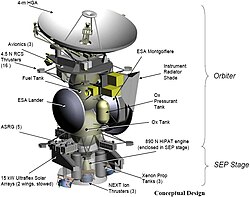Titan Saturn System Mission
ESA | |
| Website | sci.esa.int |
|---|---|
| Mission duration | 2 years (proposed)[1] |
| Spacecraft properties | |
| Launch mass | Orbiter: 1,613 kg (3,556 lb) |
| Landing mass | Montgolfière:600 kg (1,300 lb) Lander: 190 kg (420 lb) |
| Start of mission | |
| Launch date | Proposed: Between 2020 and 2029 |
| Rocket | Delta IV Heavy, Space Launch System[2] Block IB, or Atlas V |
| Orbital parameters | |
| Reference system | Titan Orbit |
Semi-major axis | 1,500 km (930 mi) |
| Inclination | 85° |
| Period | ~4.8 h |
| Epoch | Proposed |
| Titan orbiter | |
| Orbital insertion | Between 2029-2038 (proposed) |
| Titan atmospheric probe | |
| Spacecraft component | TSSM montgolfière |
| Titan lander | |
| Spacecraft component | Titan Mare Explorer or other TSSM lander proposal |
| Landing site | Ligeia Mare |
Titan Saturn System Mission (TSSM) was a joint
In 2009, a
Origin and status
This section needs to be updated. (June 2021) |
The Titan Saturn System Mission (TSSM) was officially created in January 2009 by the merging of the ESA's Titan and Enceladus Mission (TandEM) with NASA's Titan Explorer (2007) study,
In 2014 it was thought the TSSM might have been revived for a launch on the SLS super-heavy-lift rocket.[2]
Mission overview


The TSSM mission consists of an
Both probes’ data are to be relayed to a Titan orbiter. They will be equipped to study Titan's features with instruments for imaging, radar profiling, and surface as well as atmospheric sampling, much more complete than done by the Cassini–Huygens mission.
The spacecraft will use several gravity assist flybys of other planets to enable it to reach Saturn. The baseline design envisaged a September 2020 launch, followed by four gravity assists (Earth–Venus–Earth–Earth), and arrival at Saturn 9 years later in October 2029. This is one of several available Earth-to-Saturn transfer options from the year 2018 through 2022. Current NASA plans do not give the TSSM a priority, however, and it is unlikely any of the proposed launch dates can be met.
Upon Saturn arrival, in October 2029, the orbiter's chemical propulsion system would place the flight system into orbit around Saturn, followed by a two-year Saturn Tour Phase, characterized by the deployment of the in situ elements, and including a minimum of seven close Enceladus flybys and 16 Titan flybys. During this period, repeated satellite
The Montgolfière, a hot air balloon, would be released on approach to the first Titan flyby for ballistic entry into Titan's atmosphere for its six Earth months’ mission from April 2030 to October 2030. Based on Cassini–Huygens discoveries, the Montgolfière should be able to circumnavigate Titan at least once during its nominal lifetime at its deployment latitude of about 20°N, 10 kilometers above Titan's surface.
Lake lander

Numerous proposals have been brought forward with respect to the lake-lander concept. One of the most detailed plans so far is the so-called
Science goals and objectives
The major goals of the TSSM mission can be summarized under four categories:
- Explore Titan as a system
- Study Titan's organic inventory and astrobiological potential
- Constrain Titan's origin and evolution models
- Recover information on Enceladus and Saturn's magnetosphere

At Titan, the science goals would be to provide information on such aspects as the composition of the surface and the geographic distribution of the various organic constituents; on the
See also
References
- ^ a b "TANDEM/TSSM mission summary". European Space Agency. 20 October 2009. Retrieved 2009-11-08.
- ^ a b Creech, Stephen (April 2014). "NASA's Space Launch System: A Capability for Deep Space Exploration" (PDF). Strategy & Partnerships Space Launch System (SLS) Program.
- ^ Rincon, Paul (2009-02-20). "Jupiter in space agencies' sights". BBC News. Retrieved 2009-02-20.
- ^ "TSSM NASA/ESA joint summary report". ESA. 19 Jan 2009. Retrieved 2009-11-26.
- ^ "NASA and ESA Prioritize Outer Planet Missions". NASA. February 18, 2009.
- ^ Rincon, Paul (18 February 2009). "Jupiter in space agencies' sights". BBC News.
- ESA. 12 February 2009.
- ^ Hsu, Jeremy (14 October 2009). "Nuclear-Powered Robot Ship Could Sail Seas of Titan". Space.com.
- ^ a b c Stofan, Ellen (25 August 2009), "Titan Mare Explorer (TiME): The First Exploration of an Extra-Terrestrial Sea" (PDF), Presentation to NASA's Decadal Survey, Space Policy Online, archived from the original (PDF) on 2009-10-24, retrieved 2009-11-04
- ^ "NASA's Planetary Science Division Update" (PDF). June 23, 2008. Archived from the original (PDF) on September 21, 2008.



